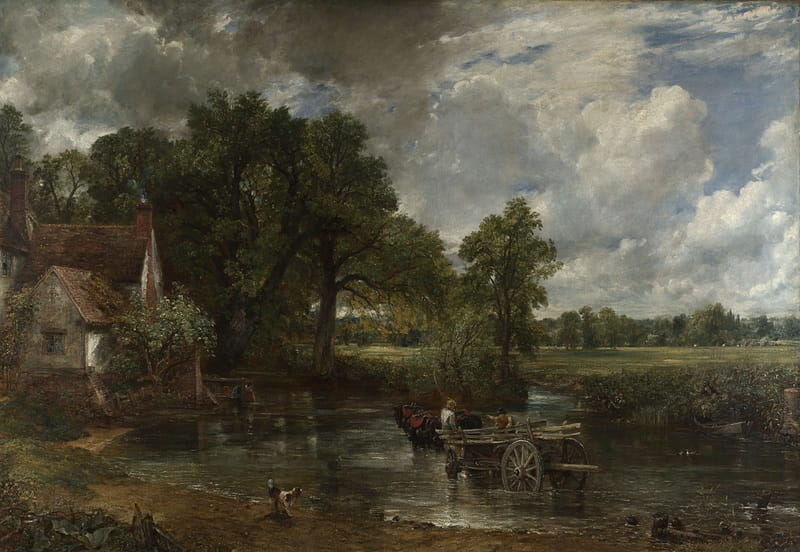The Hay Wain, John Constable’s best-known painting, is 200 hundred years old and I recently took part in a panel discussion for the National Gallery to celebrate that bicentenary.
Life Inside the Hay Wain: Constable’s Landscapes 200 Years On* was a chance to build a fresh, interdisciplinary perspective on one of the nation’s most loved paintings and suggest ways of reading the painting’s relevance to the 21st century.
My contribution was an environmentally angled enquiry into how The Hay Wain can encourage us to think about crises of our own time: current climate emergency, species loss, the effects of land management and intervention in sustainability, and the problem of reading the dangers of all of these through an overlay of nostalgia and rural charm.

The Hay Wain, by John Constable, courtesy of the National Gallery
An idyllic rural scene
One of John Constable’s giant ‘six-footer’ landscapes, The Hay Wain’s depiction of the wooden wagon, pulled by four horses and driven by two men, crossing a ford in the River Stour at Flatford, has become a defining image of the meandering valley borderland between Essex and Suffolk known as 'Constable Country.'
Visitors to the National Gallery look for this picture, just as those at the Louvre in Paris queue to view Leonardo da Vinci’s Mona Lisa. But while The Hay Wain presents viewers with a cultural memory in its scene from a bygone age, it is more importantly a vibrantly alive snapshot that puts the emphasis on impermanency rather than timelessness.
Originally exhibited in London as Landscape: Noon and subject to revision over a period of many months, the painting is premised upon moments passing into history. The billowing cumulus clouds, racing across the sky in a west wind, suggest rain in a prescient weather forecast representative of the conditions Constable preferred for his painting and sketching. Those clouds ensure an overwhelming sense of movement across the top of the painting that filters throughout the entire scene. Soon after painting The Hay Wain, Constable produced hundreds of cloud and sky studies in a process that he referred to as ‘skying.’
Unseen air pollution
My talk linked 1821 with today’s climate crisis through a series of relevant facts. Firstly, The Hay Wain’s iconic rural location was, as it is now, relatively close to London: the metropolis is about 75 miles away. By 1821 air pollution was already known to be a problem in London.
Constable’s friend Luke Howard, a founder of modern meteorology whose classification system for cloud types remains the standard, had published his ground-breaking The Climate of London three years earlier in 1818. Constable avidly followed the new science of weather and climate along with other scientific developments, reasoning in 1836 that “painting is a science and should be pursued as an enquiry into the laws of nature” .
Moreover, the rapidly expanding city, probably including evidence of its growing problem with smog, would have been visible to Constable from Hampstead Heath, close to where he had made his home (he still spent summer months sketching in and around Dedham). We might say that Constable witnessed in real time the rise of the carbon-industrial age that inevitably ushered in the Anthropocene epoch in which we live.
The lost species
Trees, like clouds and skies, were among Constable’s favourite studies. Elms loom large and healthy in The Hay Wain.
But almost all of Britain’s specimens died due to Dutch Elm disease in the second half of the 20th century (there are some remaining British elms, but not in Constable Country). None of us, then, can revisit Constable’s pastoral landscape as it appears in the painting.
Perhaps less obvious are shifts in biodiversity that were taking place due to the agricultural revolution. Older grass varieties were being displaced by imported species that provided better year-round grazing, while lime fertiliser was altering the pH balance of the soil. These changes in land management altered the variety of wildflowers present in meadows, which would onwardly have impacted the diversity of insect life.
The River Stour and rising sea levels
The river in The Hay Wain is shallow enough for the wagon to cross but deep enough to require careful navigation. A woman beside a water race at tenant farmer Willy Lott’s cottage washes clothes while another character, not easy to see, fishes from the bank on the Essex side. The fertile floodplain has produced a crop of hay that workers in the distance are gathering. Willows and the elms already mentioned flourish.
Reading the painting in the light of increasingly drier summers and rising temperatures, we might consider how much of what we see in it will become unsustainable due to changes in water levels. With Flatford’s elevation of three metres above sea level, it is likely that rising water levels due to Arctic and Antarctic ice-melt will see the area under salt water. Even if flooding doesn’t happen, inland drought and rising temperatures will likely result in wide-ranging ecological change.
Short talks raise questions as well as suggest answers. Life Inside the Hay Wain: Constable’s Landscapes 200 Years On generated a lively twitter discussion that continues. I’d love to arrange another event comparing The Hay Wain with Stratford Mill and Wivenhoe Park, the latter painted five years earlier and set in the parkland that is now part of our Colchester campus.
*The other panelists were Christine Riding, who is Jacob Rothschild Head of the Curatorial Department and Head of Curating at the National Gallery; Justin Hopper, an American author based in Dedham (The Old Weird Albion); and Roei Greenberg, a London-based Israeli-born photographer and artist who was raised close to the border with Lebanon and whose photographs look from unusual angles at thresholds and forbidden places.



